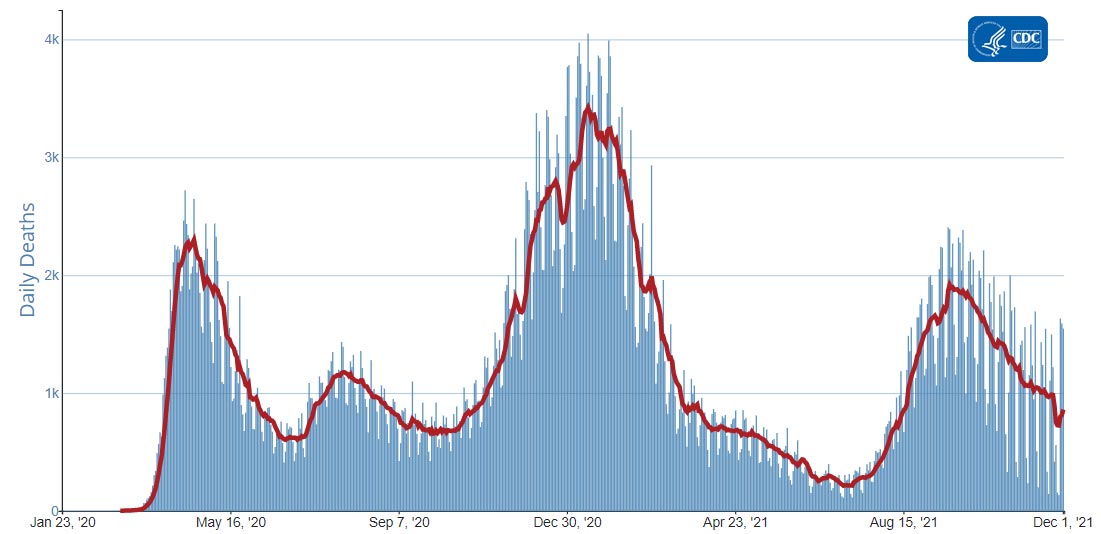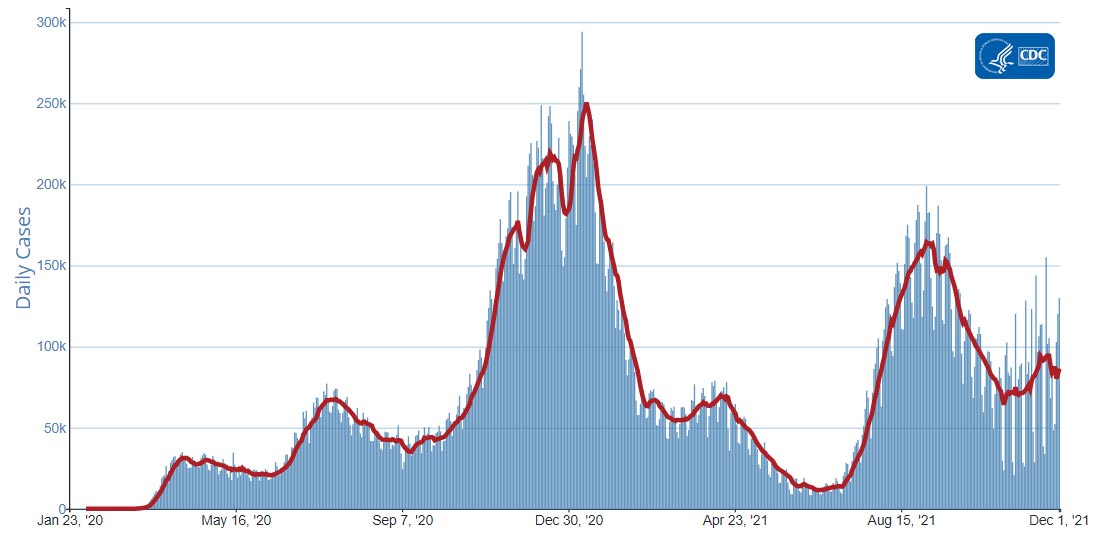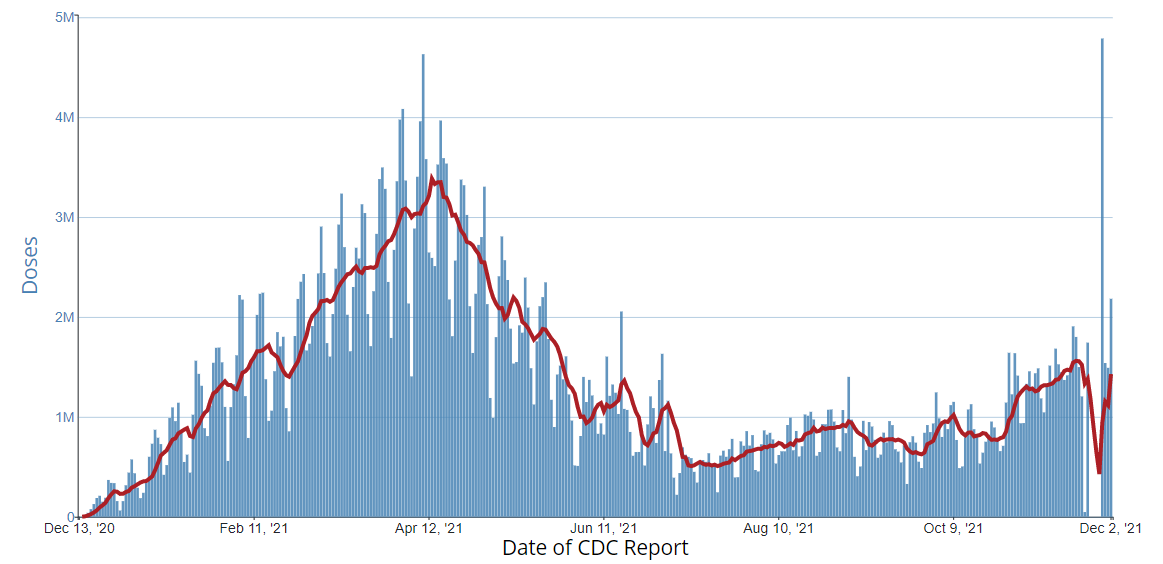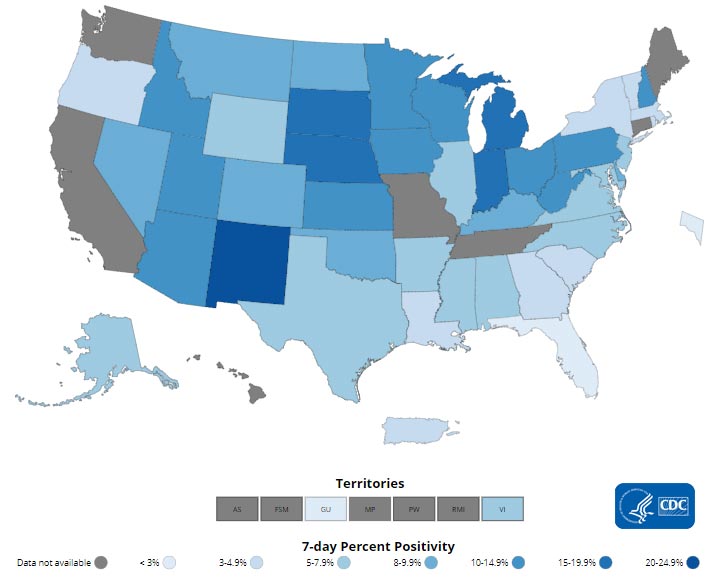Recommendations for Fully Vaccinated People
COVID-19 Homepage
Baby Talk
Interpretive Summary for December 3, 2021
Baby Talk
As of December 2, 2021, more than 234 million people in the United States have received at least one dose of a COVID-19 vaccine. However, vaccination among pregnant people remains low. CDC’s COVID Data Tracker shows that as of November 27, 2021, the proportion of fully vaccinated pregnant people has increased to 35%, but most pregnant people remain unprotected against COVID-19. CDC recommends that people who are pregnant, breastfeeding, trying to get pregnant now, or who might become pregnant in the future, get vaccinated against COVID-19. CDC also recommends that fully vaccinated pregnant people 18 years and older receive a COVID-19 booster dose.
People who are pregnant or were recently pregnant are at increased risk for severe illness from COVID-19, including ICU admission, ventilator use, and death. A recent study found that for pregnant people with COVID-19 after Delta became predominant, the risk of ICU admission was 66% higher than before Delta became predominant. The risk of needing a ventilator or special equipment to breathe was 63% higher, and the risk of death was more than 2 times higher than in the pre-Delta period.* A second study found that compared with people without a COVID-19 diagnosis at delivery, pregnant people with a COVID-19 diagnosis at delivery had nearly twice the risk of having a stillbirth.** After Delta become predominant, women with COVID-19 during pregnancy had 4 times the risk of having a stillbirth.
Getting a COVID-19 vaccine can prevent severe illness, death, and pregnancy complications related to COVID-19. CDC data show that COVID-19 vaccines are safe for people who are pregnant, including those early in pregnancy. Additionally, there is currently no evidence that any vaccines, including COVID-19 vaccines, cause fertility problems in women or men. Many people have become pregnant after receiving a COVID-19 vaccine, including some who got vaccinated during COVID-19 vaccine clinical trials. If you have questions about getting vaccinated, talk with your healthcare provider. To find a vaccine provider near you, visit vaccines.gov; text your ZIP code to 438829 (GETVAX); or call 1-800-232-0233.
*The risk for severe illness also increased for non-pregnant women of reproductive age (15─44 years) with COVID-19 during the Delta period, compared with the pre-Delta period.
**COVID-19 diagnosis may have represented a current or past infection.
Note to readers: CDC’s COVID Data Tracker now features a Pregnancy Data page which catalogs all pregnancy-related data available on COVID Data Tracker and provides links to resource on COVID-19 in pregnancy. Resources and tools are available to help people who are pregnant, breastfeeding, and new parents caring for infants protect their health.
- COVID Data Tracker’s Vaccination Demographics tab now shows booster dose data for people 65 years and older by race/ethnicity, age, and sex
- COVID Data Tracker’s Vaccination Demographic Trends tab now displays vaccination trends by age and sex, vaccination trends by race/ethnicity, and booster trends by age, sex, and race/ethnicity among people 65 years and older
- COVID Data Tracker now displays vaccination data among nursing home residents and staff and dialysis center patients and staff
- COVID Data Tracker’s Vaccine Confidence and Coverage Estimates tab now displays vaccination status and intent among children by age, race/ethnicity, sex, and sociodemographic characteristics
- Risk for Stillbirth Among Women With and Without COVID-19 at Delivery Hospitalization — United States, March 2020–September 2021
- COVID-19–Associated Deaths After SARS-CoV-2 Infection During Pregnancy — Mississippi, March 1, 2020–October 6, 2021
- COVID-19 Severity among Women of Reproductive Age with Symptomatic Laboratory-Confirmed SARS-CoV-2 by Pregnancy Status – United States, Jan 1, 2020 – Sep 30, 2021
Reported Cases
The current 7-day moving average of daily new cases (86,413) decreased 8.5% compared with the previous 7-day moving average (94,393). A total of 48,628,787 COVID-19 cases have been reported as of December 1, 2021.
On November 26, 2021, the World Health Organization (WHO) classified a new variant, B.1.1.529, as a Variant of Concern (VOC) and named it Omicron. On November 30, 2021, the United States also classified it as a VOC. On December 1, 2021, CDC announced that the first confirmed case of Omicron variant had been detected in the United States. Additional suspected cases of Omicron are being investigated. Despite the detection of Omicron, Delta remains the predominant strain in the United States. Nowcast projections* for the week ending November 27, 2021, estimate the national and regional proportions of Delta to be greater than 99%.
CDC has been actively monitoring and preparing for this variant and will continue to work with other U.S. and global public health and industry partners to learn more. For more information on variant proportions, visit COVID Data Tracker.
48,628,787
Total Cases Reported
48,628,787
Total Cases Reported
86,413
Current 7-Day Average**
86,413
Current 7-Day Average**
94,393
Prior 7-Day Average
94,393
Prior 7-Day Average
-8.5%
Change in 7-Day Average since Prior Week
-8.5%
Change in 7-Day Average since Prior Week
* The median time from specimen collection to sequence data reporting is about 3 weeks. As a result, weighted estimates for the most recent few weeks may be unstable or unavailable. CDC’s Nowcast is a data projection tool that helps fill this gap by generating timely estimates of variant proportions for variants that are circulating in the United States. View Nowcast estimates on CDC’s COVID Data Tracker website on the Variant Proportions page.
** Historical cases are excluded from daily new cases and 7-day average calculations until they are incorporated into the dataset for the applicable date. Of 348,267 historical cases reported retroactively, 574 were reported in the current week and 11,899 were reported in the prior week.
Vaccinations
The U.S. COVID-19 Vaccination Program began December 14, 2020. As of December 2, 2021, 464.4 million vaccine doses have been administered. Overall, about 234.3 million people, or 70.6% of the total U.S. population, have received at least one dose of vaccine. About 197.8 million people, or 59.6% of the total U.S. population, have been fully vaccinated.* About 43.0 million additional/booster doses in fully vaccinated people have been reported. As of December 2, 2021, the 7-day average number of administered vaccine doses reported (by date of CDC report) to CDC per day was 1,428,263, a 22.0% increase from the previous week.
CDC’s COVID Data Tracker Vaccination Demographic Trends tab shows vaccination trends by age group. As of December 2, 2021, 99.9% of people ages 65 years or older have received at least one dose of vaccine and 86.4% are fully vaccinated. More than three-quarters (83.0%) of people ages 18 years or older have received at least one dose of vaccine and 71.3% are fully vaccinated. For people ages 12 years or older, 81.0% have received at least one dose of vaccine and 69.5% are fully vaccinated. For people ages 5 years or older, 75.0% have received at least one dose of vaccine and 63.4% are fully vaccinated.
464,445,580
Vaccines Administered
464,445,580
Vaccines Administered
234,269,053
People who received at least one dose
234,269,053
People who received at least one dose
197,838,728
People who are fully vaccinated*
197,838,728
People who are fully vaccinated*
70.6%
Percentage of the US population that has received at least one dose
70.6%
Percentage of the US population that has received at least one dose
59.6%
Percentage of the US population that has been fully vaccinated*
59.6%
Percentage of the US population that has been fully vaccinated*
+0.9
Percentage point increase from last week
+0.9
Percentage point increase from last week
+0.5
Percentage point increase from last week
+0.5
Percentage point increase from last week
*Represents the number of people who have received the second dose in a two-dose COVID-19 vaccine series (such as the Pfizer or Moderna vaccines) or one dose of the single-shot Johnson & Johnson’s Janssen vaccine.
Hospitalizations
New Hospital Admissions
The current 7-day daily average for November 24–November 30, 2021, was 6,386. This is a 5.0% increase from the prior 7-day average (6,082) from November 17–November 23, 2021.
3,419,480
Total New Admissions
3,419,480
Total New Admissions
6,386
Current 7-Day Average
6,386
Current 7-Day Average
6,082
Prior 7-Day Average
6,082
Prior 7-Day Average
+5.0%
Change in 7-Day Average
+5.0%
Change in 7-Day Average
The start of consistent reporting of hospital admissions data was August 1, 2020.
Daily Trends in Number of New COVID-19 Hospital Admissions in the United States

New admissions are pulled from a 10 am EST snapshot of the HHS Unified Hospital Timeseries Dataset. Due to potential reporting delays, data from the most recent 7 days, as noted in the figure above with the grey bar, should be interpreted with caution. Small shifts in historic data may also occur due to changes in the Centers for Medicare and Medicaid Services (CMS) Provider of Services file, which is used to identify the cohort of included hospitals.
COVID-NET: Hospitalizations in Non-Hispanic American Indian and Alaska Native People
CDC’s Coronavirus Disease 2019-Associated Hospitalization Surveillance Network (COVID-NET) shows that since the start of the pandemic, people from racial and ethnic minority groups have been at increased risk for COVID-19-associated hospitalizations compared to non-Hispanic White people. For the week ending November 13, 2021, the rate of COVID-19-associated hospitalizations in non-Hispanic American Indian/Alaska Native people was 23 per 100,000 people. This is the highest hospitalization rate among all racial and ethnic minority groups and represents a substantial increase over the past three months.*
* It is important to note that these increases might be driven by a limited number of COVID-NET sites and might not be nationally representative.
Hospitalizations in Non-Hispanic American Indian and Alaska Native People

The Coronavirus Disease 2019 (COVID-19)-Associated Hospitalization Surveillance Network (COVID-NET) is an additional source for hospitalization data collected through a network of more than 250 acute-care hospitals in 14 states (representing ~10% of the U.S. population). Detailed data on patient demographics, including race/ethnicity, underlying medical conditions, medical interventions, and clinical outcomes, are standardized case reporting form.
Deaths
The current 7-day moving average of new deaths (860) has decreased 12.6% compared with the previous 7-day moving average (983). As of December 1, 2021, a total of 781,963 COVID-19 deaths have been reported in the United States.
781,963
Total Deaths Reported
781,963
Total Deaths Reported
860
Current 7-Day Average*
860
Current 7-Day Average*
983
Prior 7-Day Average
983
Prior 7-Day Average
-12.6%
Change in 7-Day Average Since Prior Week
-12.6%
Change in 7-Day Average Since Prior Week
* Historical deaths are excluded from the daily new deaths and 7-day average calculations until they are incorporated into the dataset by their applicable date. Of 14,561 historical deaths reported retroactively, 230 were reported in the current week; and 3,052 were reported in the prior week.
Daily Trends in Number of COVID-19 Deaths in the United States Reported to CDC

7-Day moving average
 More Death Data
More Death DataTesting
The percentage of COVID-19 NAATs (nucleic acid amplification tests)* that are positive (percent positivity) has increased from the previous week. The 7-day average of percent positivity from NAATs is now 7.8%. The 7-day average number of tests reported for November 19 – November 25, 2021, was 1,188,742, down 17.6% from 1,441,869 for the prior 7 days.
665,853,403
Total Tests Reported
665,853,403
Total Tests Reported
1,188,742
7-Day Average Tests Reported
1,188,742
7-Day Average Tests Reported
7.8%
7-Day Average % Positivity
7.8%
7-Day Average % Positivity
6.2%
Previous 7-Day Average % Positivity
6.2%
Previous 7-Day Average % Positivity
+1.57
Percentage point change in 7-Day Average % Positivity since Prior Week
+1.57
Percentage point change in 7-Day Average % Positivity since Prior Week
*Test for SARS-CoV-2, the virus that causes COVID-19




